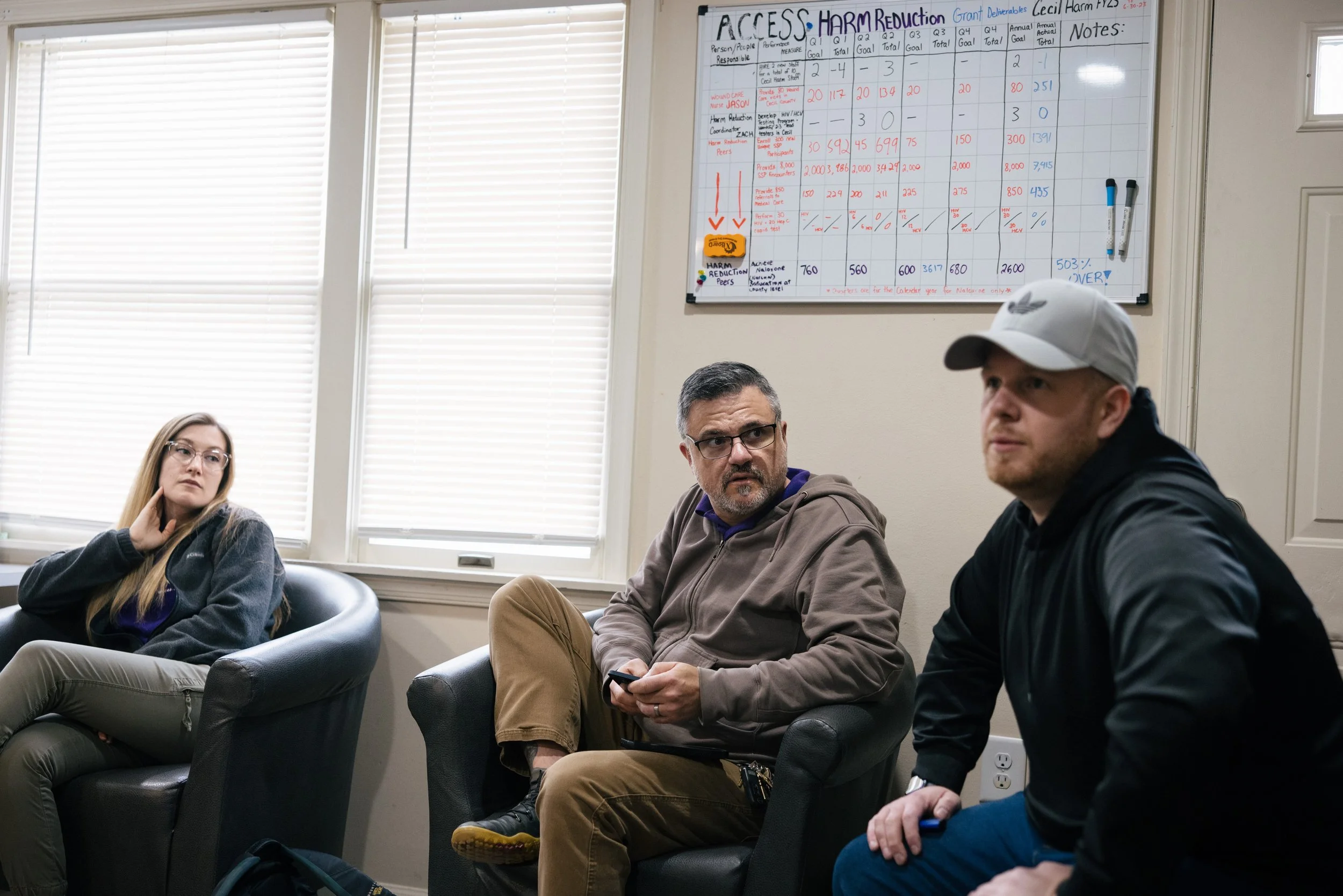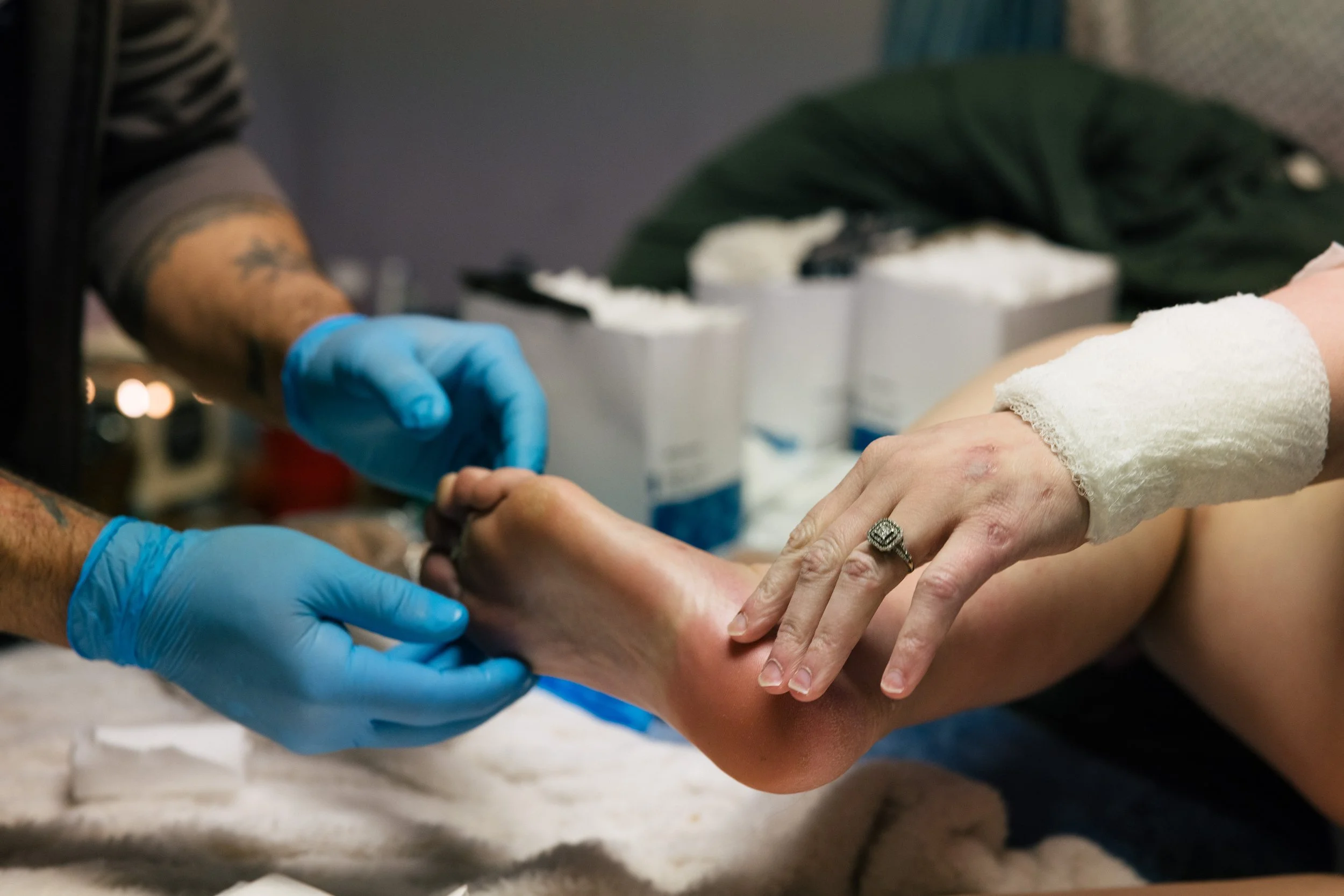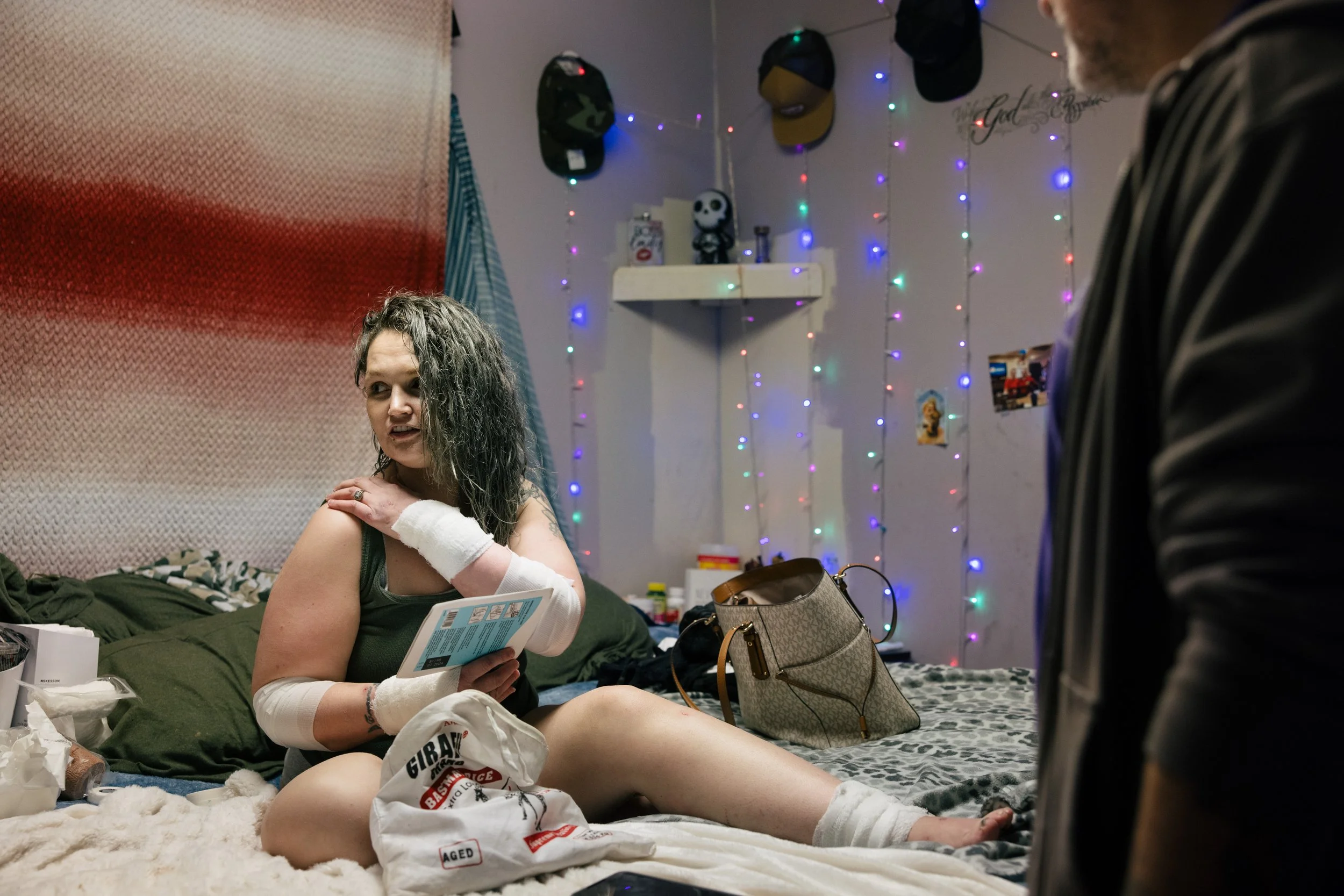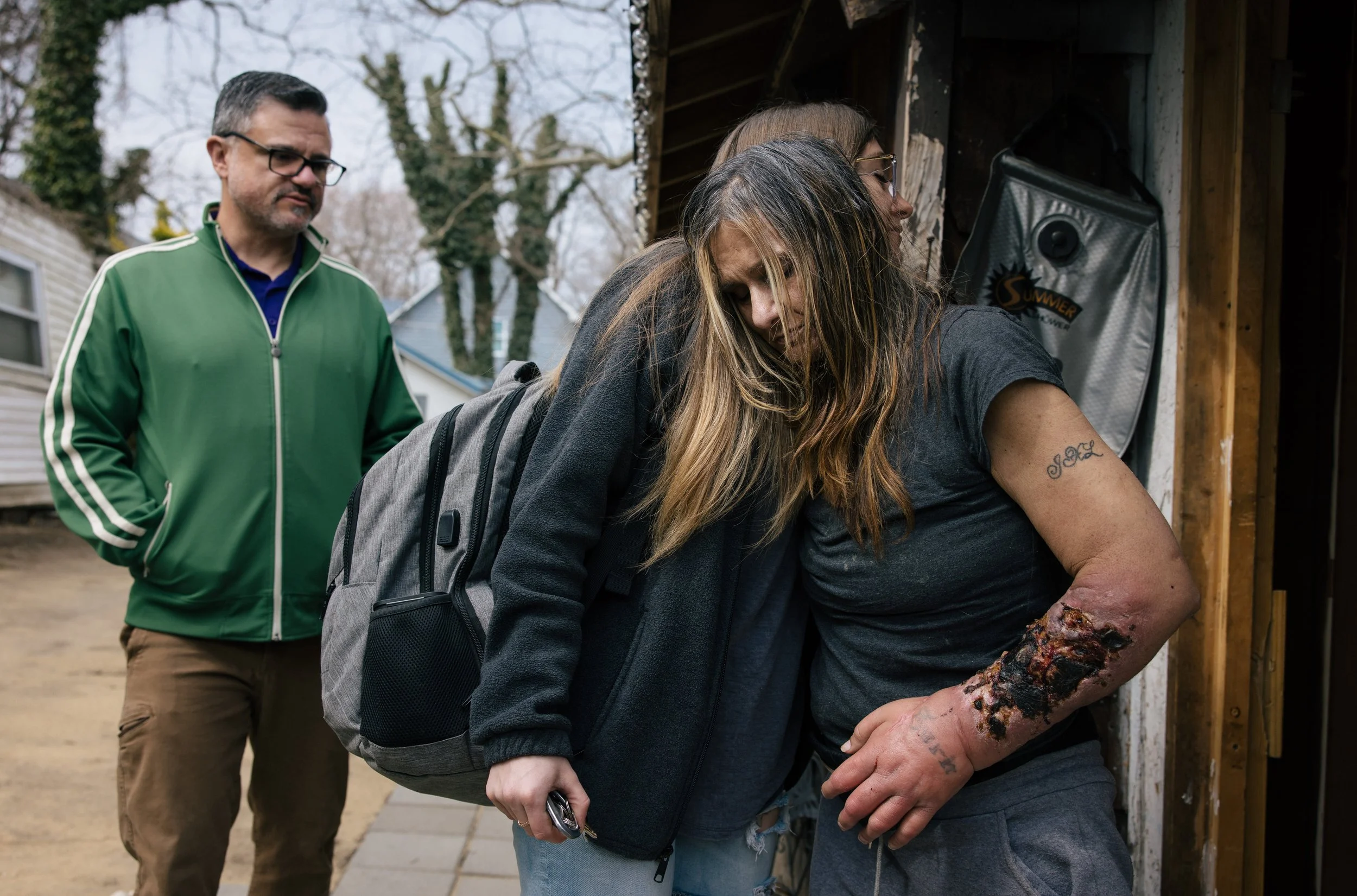Kayla Peters, left, and Jason Bienert, center, assist Tina Hutchins, who developed wounds as a result of the animal tranquilizer xylazine.
Nurses Make House Calls to Treat ‘Tranq’ Wounds for Users at Society’s Edge
Xylazine has permeated fentanyl supplies, causing wounds and amputations
Written and photographed for the Wall Street Journal. Byline: Alyssa Schukar and Julie Wernau
***Content Warning*** The following story contains material that may be harmful or traumatizing to some audiences
It was late 2020 when Jason Bienert noticed unusual wounds among a half-dozen of the fentanyl users he works with as a nurse in northeast Maryland.
Unlike the red, swollen abscesses he was used to seeing on people who inject illicit opioids, these were painful ulcers that started small and dark before consuming the surrounding skin and tissue. Some wounds led to amputation. Others were life threatening.
The culprit was xylazine, an animal tranquilizer that has since pervaded the region’s drug supply, compounding the opioid crisis and leaving people who survive disabled. Drug users become addicted to more than one substance without knowing what they injected.
“A lot of the wound-care people I’ve seen are in recovery now,” Mr. Bienert said. “Or they’re no longer alive.”
The Drug Enforcement Administration said about a quarter of seized fentanyl powder last year contained xylazine, known to some users as “tranq.” Once largely contained to the Philadelphia region and Puerto Rico, xylazine has been found in illicit drugs in 48 states.
Nurses around the country who have heard about Mr. Bienert’s work send him photos at all hours, asking him to identify wounds they are seeing at hospitals in Buffalo, N.Y., and Baltimore.
“Some hospitals don’t know what xylazine is,” he said.
Jason Bienert, center, meets with the team at Voices of Hope before making house calls.
Mr. Bienert visits drug users throughout Maryland’s Cecil County for Voices of Hope, a nonprofit that offers treatment, syringe exchanges, naloxone training and other care to users.
“The seldom seen, the shadows of people you step over or you ignore,” he said, “we actually engage them.”
Kayla Peters, a fellow wound-care nurse, said many people with severe wounds or infections won’t return to hospitals and clinics where they say they were disrespected. “We’re working with people who are not regularly going to a doctor,” she said.
Mr. Bienert and Ms. Peters brought medical supplies to the home of Tina Hutchins, 35, so she could continue to care for herself.
About a dozen new xylazine wounds had spread across her arms and legs. One on her foot needed additional care, but she was hesitant to go to the doctor. “The hospitals treat addicts so bad,” she said. A doctor who lanced a wound two months earlier was rude and rough with her, she said.
In the first quarter of this year, Mr. Bienert, left, treated more than 200 people with xylazine wounds. He is training fellow wound-care nurse Kayla Peters to care for people across Cecil County, population 104,000.
The xylazine wounds confounded Mr. Bienert until he tried xeroform, a gauze dressing for burn victims that keeps skin warm while softening hardened tissue above wounds.
Mr. Bienert and Ms. Peters brought medical supplies to the home of Tina Hutchins, 35, so she could continue to care for herself.
Mr. Bienert makes a point of involving people in their own healthcare.
“The wound is simple to assess. If it’s wet, it needs to be dry. If it’s dry, it needs to be moist. If it’s not covered, it needs to be covered,” he said.
He tells users he believes in them.
“If they do decide to get clean or enter recovery, maybe they’ll still have their arm, maybe they’ll still have their hand,” Ms. Peters said.
Some people give empty drug bags to Mr. Bienert who sends swabs for analysis to the National Institute of Standards and Technology.
Beau LaPoint, a longtime drug user, is staying with a friend in the Cecil County town of Elkton while she recuperates from treatment of xylazine wounds. To address tissue death, a surgeon removed the skin from her shin and calf, laying bare the flesh below.
Mr. Bienert examined the surgical excision of dead tissue. Ms. LaPoint should have been recovering in a hospital, Mr. Bienert said. Many people addicted to opioids leave hospitals rather than go through withdrawal. The paperwork from Ms. LaPoint’s hospital stay called for wound care and physical therapy, but she doesn’t have a car or a way to make appointments.
The nurses identified a fresh xylazine wound on Ms. LaPoint’s knee. Mr. Bienert instructed Ms. LaPoint how to care for the damaged skin. “I don’t know what I’d do without him,” she said.
Beau LaPoint is recuperating from treatment of xylazine wounds.
Left, Ms. LaPoint’s wounds were so bad, a surgeon removed the skin from her shin and calf. Right, Mr. Bienert rebandages Ms. LaPoint’s leg.
Mr. Bienert and Ms. Peters drove half an hour from Elkton to visit Tanya Semon in Crystal Beach, a town along the Elk River.
Mr. Bienert couldn’t reach Ms. Semon by phone. He made the drive anyway because he said he knew she needed supplies. Mr. Bienert knocked on Ms. Semon’s door and heard movement inside, then silence.
“It’s Jason from Voices,” he said. The lock clicked, and the door opened. Ms. Semon was relieved to see the wound nurses and began to cry. She said she thought they were the police.
Ms. Semon showed Mr. Bienert her swollen left hand and the xylazine wounds covering both forearms. The wounds terrified her. She tried to cut out some of the hardened skin and had been in pain through the night.
Mr. Bienert and Ms. Peters travel to their next location to provide supplies to a patient.
They hadn’t been able to reach Tanya Semon by phone before their arrival.
Ms. Semon had cut out some of the hardened skin and had been in pain through the night.
Ms. Semon took a seat. The nurses knelt next to her. They said they couldn’t care for her wounds that day because they needed to be cleaned first, ideally at a hospital.
Ms. Semon has had worse wounds. Mr. Bienert said he was concerned about chronically damaged flesh and exposed bone that could require amputation. Hoping to save her dominant right hand, she told Mr. Bienert she would inject drugs into her left arm from then on.
Mr. Bienert and Ms. Peters reminded Ms. Semon of recovery services that Voices of Hope offers. Ms. Peters gave Ms. Semon safe-use kits with new syringes. Mr. Bienert said he would check in again after a few days.
Involving people in their own healthcare maintains their dignity and sense of control, Mr. Bienert said. When they are ready, they can receive recovery support.
“You’re taking care of yourself,” he tells them.











